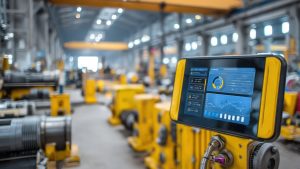The buzz around artificial intelligence is impossible to ignore. It seems like every industry is exploring how to use these AI systems, including maintenance. This brings up bold claims of “AI in Maintenance: Separating Hype from Reality,” but is it all it is cracked up to be?
It is easy to get caught up in the excitement, but you are going to want to separate what’s real from marketing spin. Many readers might wonder why this is even needed when things have been overhyped.
Table of Contents:
- The Rise of AI in Maintenance
- The Hype: What’s Overpromised?
- The Reality: What AI Actually Delivers
- Challenges of Implementing AI in Maintenance
- AI in Maintenance: The Future Outlook
- Conclusion
The Rise of AI in Maintenance
AI is truly changing how businesses operate. Maintenance is definitely one area seeing these impacts with predictive analytics, process automation, and machine learning methods.
Think about manufacturing. Companies like Customertimes point out that AI is not always a magic solution, but can help with quality control or supply chain optimization.
AI-driven tools, such as advanced analytics apps powered by AI and machine learning, give businesses fast insights. Qu’s Notify app is a perfect example, letting restaurant brands make quick decisions based on data.
The Hype: What’s Overpromised?
AI won’t immediately replace human workers. People are critical for understanding the information AI gives us.
It is best used with humans who can truly review that information.
AI Eliminates the Need for Human Technicians
AI is a powerful tool, but it is not going to take the place of people any time soon. Skilled technicians have years of on-the-job experience.
Humans use judgment, experience, and wisdom from all this experience. This happens in real-time while models still need to catch up to it. For instance, who is better to tell whether a building is wired properly for electrical usage based on current usage: humans or robots?
This goes double or triple for unusual problems or emergencies.
AI Guarantees Zero Downtime
Predictive maintenance can drastically cut downtime; that is a fact. However, the technology doesn’t get rid of every possible problem.
Unexpected failures still occur, and systems have their limits. A maintenance team will still be needed because things always require maintenance no matter the scenario.
AI is Plug-and-Play
This might be the biggest misconception out there. Many think you can simply install AI solutions, and they can start fixing problems quickly.
The fact is, AI needs a lot of preparation. AI systems are often trained with past data, so they give great insights, and just setting up data sources can be complicated.
The Reality: What AI Actually Delivers
After bursting some of those hyped-up bubbles, what can AI *really* do for maintenance teams? It turns out, still quite a bit.
Smarter Predictive Maintenance
AI’s true ability is analyzing large amounts of equipment data to predict equipment failure ahead of time. This data might include vibration readings, temperature changes, or even sound anomalies.
Industries are showing this approach delivers measurable success. For example, TTEC reports that AI is helping companies reduce supply chain costs, saving manufacturers vast amounts of money.
AI gives even more focused recommendations than before on a timetable that better fits company processes. See below for a direct comparison of predictive maintenance capabilities when AI has or does not have machine learning data capabilities.
| Predictive Maintenance (Traditional, Non-AI) | Predictive Maintenance (Enhanced with Machine Learning) | |
|---|---|---|
| Data Sources Used | – Individual sensors, – Scheduled inspections |
– Large volume data sets, – Diverse Data sources, – Sensors and equipment data |
| Decision-Making Power | – Human interpretation and knowledge | – Fast computer calculations and human guidance |
Optimized Maintenance Scheduling
AI systems can help you prioritize your work, basing it on urgency and availability. AI will help find tasks to avoid doing at all.
This means less wasted effort on machines that will still operate normally. You focus your effort when it is truly important and avoid unneeded labor costs.
Cost Savings and Efficiency Gains
Making machine reliability better lowers repair costs. This will ultimately limit how often you need to completely replace items, and AI helps teams work better and smarter overall.
The point of efficiency gains is how a machine handles tasks. These traditionally took up most of a worker’s valuable time.
Now, a computer does it faster. A person with specialist knowledge then determines whether the final word makes sense.
Challenges of Implementing AI in Maintenance
Even with clear benefits, implementing AI in maintenance is not always smooth sailing. You must plan for difficulties before starting to use these AI systems.
Setting things up might be difficult, and the first expense may be expensive. Making your old equipment work correctly with new AI systems can get involved.
Having useful and usable data is super important. The information your AI is processing also has to be “clean,” and ongoing cleaning will almost certainly need to be done.
Teams might simply resist these changes, so it can take time to learn to get good data. Investing the time into learning the new systems is crucial to adopting cutting edge AI technology.
AI in Maintenance: The Future Outlook
There is no question about it; AI’s role will only keep increasing in how maintenance is managed. We are already moving into concepts often described as “Industry 5.0,” where collaboration between human and artificial intelligence is more powerful.
Businesses need to start planning how to incorporate this powerful data and automation. This enhances what human workers accomplish. NYU’s Center for Data Science reminds us that a lot of current AI technology has origins that go back years.
It’s really more of a series of waves of progress. Businesses must learn from past experience and research for an optimal implementation. The evolution is ongoing, with continual improvements in technology. The restaurant industry sees this value first-hand, and brands are investing, mainly through vision technologies driven by AI this year, according to Qu’s 5th Annual State of Digital report.
Conclusion
So, what’s the bottom line on “AI in Maintenance: Separating Hype from Reality”? While AI offers major potential improvements, not every organization—especially in manufacturing—will see immediate benefits. The key is distinguishing between real value and AI hype to ensure practical implementation.
When applied effectively, AI can significantly enhance customer experience by reducing downtime, predicting maintenance needs, and streamlining operations. It won’t replace jobs, but it will automate repetitive, mundane, and routine tasks, allowing skilled workers to focus on higher-value activities. Businesses that leverage generative AI can further optimize maintenance strategies, improving efficiency and decision-making.
Beyond operational benefits, AI-driven maintenance strategies can also boost revenue by minimizing unexpected equipment failures, extending asset lifespan, and improving overall productivity. Additionally, enhanced customer service results from fewer disruptions and faster issue resolution, reinforcing business reliability.
Companies exploring “AI in Maintenance: Separating Hype from Reality” must take a strategic approach—identifying the right timing, methods, and balance between AI adoption and traditional maintenance practices. The right integration can transform operations, improve efficiency, and drive long-term success.



